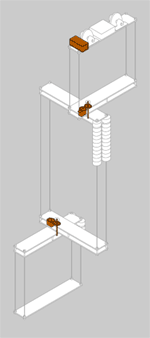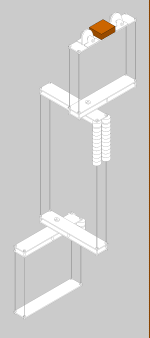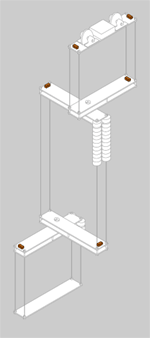overview
trundle
v1.2
+
anatomy
images
behavior
interaction
movement
trundle v1.1
anatomy
images
behavior
trundle v1.0
anatomy
images |
 |
 |
Structure
The primary structural framework of Trundle is made from 3/16" aluminum
panels and 1/8" stainless steel rods. Steel counterweights are used
for balancing the asymmetric joints. Connections are made with shaft
collars. Each of the three sections are attached by a single 0.25"
steel rod, thus making the structure prone to oscillation and vibration.
When the sections are not connected with gears, the sculpture is
a smooth, continuously moving mobile. Extremely fluid Abec-5 bearings
and the high mass of the counterweights give the sculpture a high
inertia which keeps it in motion for a long duration. As a direct
result, a large force is required to stop it from turning. |
 |
 |
Actuators
Trundle has three degrees of freedom. Its two cascading servo motors
each have a range of movement from 0° to 180° giving it a wide range
of motion. A standard DC motor mounted on the top facilitates lateral
movement. These motors in combination with the physical constraints
of the body define Trundle's movement.
Trundle’s Servo Movement
+ Range of movement from 0 – 180°
+ Position set in software
+ Ease in and out of high speed to reduce overshooting
+ Due to tremendous inertia, servos must move in moderated intervals
Trundle’s DC Motor Movement
+ 360° rotation in both directions
+ Variable speed set through pulse-width modulator (PWM)
+ Ease in and out of speeds to avoid abrupt vibration
+ Minimal speed change possible due to weight of sculpture |
 |
 |
Control
System
The core of Trundle’s control system is a 68HC11 microprocessor
which is situated in a Handyboard, an MIT designed controller board.
Trundle’s software for processing input and controlling its motors
is written in the Interactive C programming language. The Handyboard
provides a wonderful environment for creating fast prototypes. It
contains 4 motor ports, 6 servo ports, 16 analog inputs, 9 digital
inputs, and 9 digital outputs. |
 |
 |
Sensors
Trundle senses the world through an array of sensors which allows
it to receive information from its environment. In the spirit of
experimentation, many different sensors have been tested during
Trundle's evolution. The current version of Trundle uses six Sharp
GP2D12 Infrared Rangers (IR) to sense the world:
Sharp GP2D12 Infrared Ranger
+ Continuous distance readings
+ Reports the distance as an analog voltage
+ Approximately 4"– 30" detection
This sensor works by sending a pulse of IR light through its emitter.
If the light hits an object it is reflected back, creating a triangle
between the send, receive, and reflection point. The emitter for
this sensor is a precision lens that reflects light onto a small
linear CCD array. The way the light falls on the CCD array makes
it possible to calculate the distance from the object. Advantages
to the Sharp GP2D12 are an immunity to ambient light interference,
indifference to color, and low power consumption.
|
|

